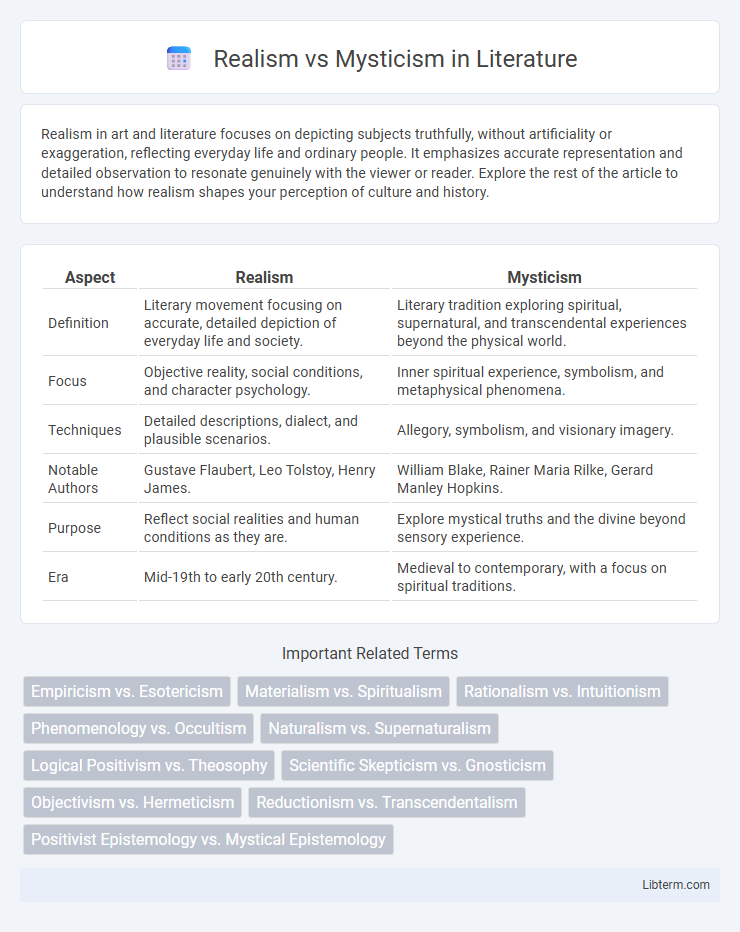Realism in art and literature focuses on depicting subjects truthfully, without artificiality or exaggeration, reflecting everyday life and ordinary people. It emphasizes accurate representation and detailed observation to resonate genuinely with the viewer or reader. Explore the rest of the article to understand how realism shapes your perception of culture and history.
Table of Comparison
| Aspect | Realism | Mysticism |
|---|---|---|
| Definition | Literary movement focusing on accurate, detailed depiction of everyday life and society. | Literary tradition exploring spiritual, supernatural, and transcendental experiences beyond the physical world. |
| Focus | Objective reality, social conditions, and character psychology. | Inner spiritual experience, symbolism, and metaphysical phenomena. |
| Techniques | Detailed descriptions, dialect, and plausible scenarios. | Allegory, symbolism, and visionary imagery. |
| Notable Authors | Gustave Flaubert, Leo Tolstoy, Henry James. | William Blake, Rainer Maria Rilke, Gerard Manley Hopkins. |
| Purpose | Reflect social realities and human conditions as they are. | Explore mystical truths and the divine beyond sensory experience. |
| Era | Mid-19th to early 20th century. | Medieval to contemporary, with a focus on spiritual traditions. |
Understanding Realism: Foundations and Philosophies
Realism is grounded in the assertion that reality exists independently of human perception, emphasizing objective truths that can be discovered through empirical observation and logical reasoning. Philosophers such as Aristotle and John Locke championed this ontology, positing that the external world and its properties remain constant regardless of individual beliefs or consciousness. This foundation contrasts with mysticism by prioritizing verifiable evidence and rational analysis over subjective spiritual experiences or metaphysical speculation.
Defining Mysticism: Core Concepts and Traditions
Mysticism centers on the direct, experiential union with ultimate reality or the divine, emphasizing personal spiritual insight beyond rational comprehension. Core concepts include transcendence, inner illumination, and the dissolution of the ego to achieve higher consciousness, found across traditions such as Sufism, Christian mysticism, and Advaita Vedanta. These mystical paths prioritize subjective experience and transformative states that challenge materialist or realist worldviews.
Historical Perspectives: Realism and Mysticism Through the Ages
Realism, rooted in ancient Greek philosophy with figures like Aristotle, emphasizes empirical observation and the existence of an objective reality independent of perception. Mysticism, tracing back to early religious traditions such as Neoplatonism and Eastern spiritual paths, centers on direct, transcendental experiences beyond rational understanding. Throughout history, these perspectives often intersected and diverged, shaping philosophical, religious, and scientific discourses from the Middle Ages to the Enlightenment and into modern thought.
Realism vs Mysticism: Key Differences and Overlaps
Realism emphasizes objective reality, asserting that the external world exists independently of perception, while Mysticism centers on direct, often transcendent, experiences beyond ordinary sensory knowledge. Key differences lie in Realism's reliance on empirical evidence and logical reasoning versus Mysticism's focus on inner spiritual insights and metaphysical truths. Overlaps occur when philosophical realism acknowledges the subjective nature of perception, allowing for mystical experiences as part of human consciousness without dismissing empirical reality.
Realism in Science and Critical Thinking
Realism in science emphasizes the belief that the external world exists independently of our perceptions, advocating for empirical evidence and reproducible experiments as the foundation of knowledge. Critical thinking underpins this approach by encouraging skepticism, logical analysis, and the rigorous evaluation of hypotheses to separate factual information from assumptions or biases. This framework supports the development of scientific theories that accurately reflect reality, prioritizing observable data over subjective or mystical interpretations.
Mysticism’s Influence on Spirituality and Religion
Mysticism profoundly shapes spirituality and religion by emphasizing direct, personal experiences of the divine that transcend empirical reality. It fosters practices such as meditation, prayer, and contemplation to attain higher states of consciousness and spiritual insight. This influence cultivates a worldview where faith, intuition, and inner transformation take precedence over rationalism and observable phenomena.
Debates: Objective Reality vs Subjective Experience
Debates between realism and mysticism center on whether objective reality exists independently of human perception or if reality is fundamentally shaped by subjective experience. Realism asserts that a material world exists outside individual consciousness, verified through empirical evidence and consistent laws. Mysticism emphasizes the primacy of inner experience and consciousness, arguing that reality is accessible primarily through personal, transcendent states beyond empirical observation.
Notable Thinkers and Influencers in Both Camps
Realism boasts notable thinkers such as Aristotle, whose emphasis on empirical observation laid the foundation for scientific inquiry, and Ayn Rand, who championed objective reality in philosophy. Mysticism features influential figures like Meister Eckhart, known for his writings on the experiential union with the divine, and Helena Blavatsky, a key founder of Theosophy promoting esoteric knowledge. The contrasting perspectives of these thinkers highlight the enduring debate between observable reality and transcendent experience.
Realism and Mysticism in Modern Society
Realism in modern society emphasizes empirical evidence, scientific reasoning, and observable facts as the foundation for understanding reality and making decisions. Mysticism persists as a counterbalance, offering spiritual insight and personal experience as sources of knowledge that often transcend rational explanation. The ongoing tension between realism and mysticism shapes cultural dialogues on truth, belief systems, and the interpretation of human experience in contemporary life.
Bridging the Gap: Can Realism and Mysticism Coexist?
Realism emphasizes observable facts and empirical evidence, while mysticism explores subjective spiritual experiences beyond sensory perception. Bridging the gap requires recognizing that both perspectives offer valuable insights into human existence, where realism provides a foundation of objective truth and mysticism enriches understanding through inner knowledge. Integrating these approaches fosters a more holistic worldview that embraces rational inquiry and transcendent meaning simultaneously.
Realism Infographic

 libterm.com
libterm.com